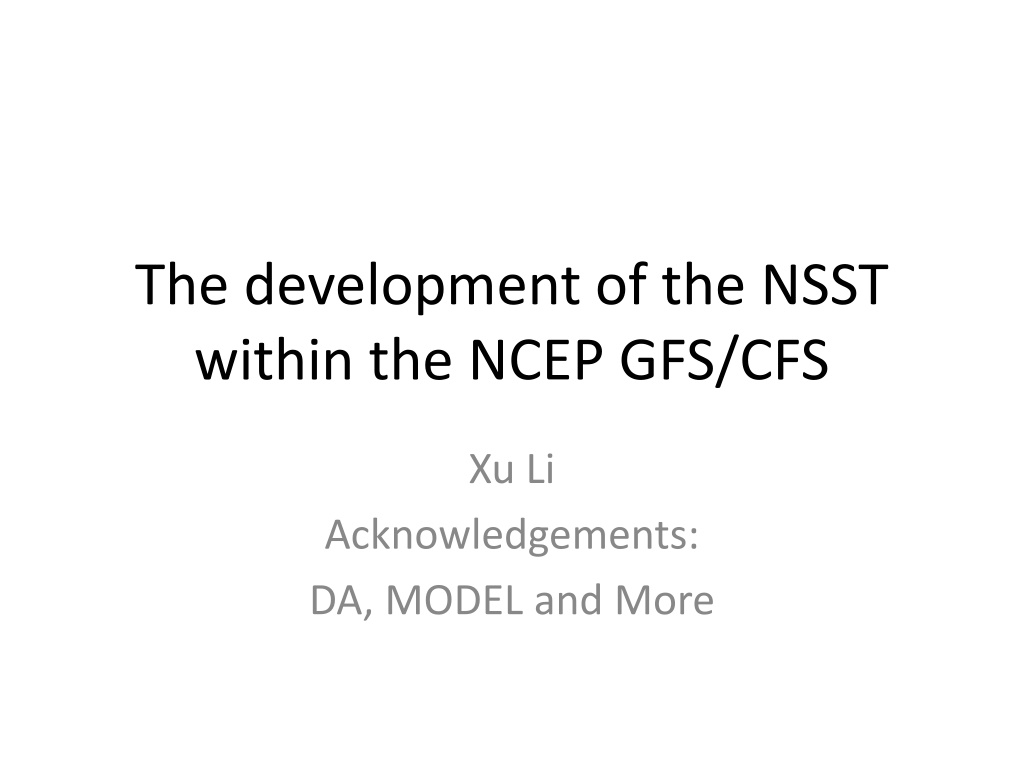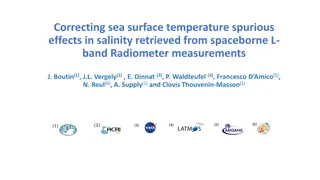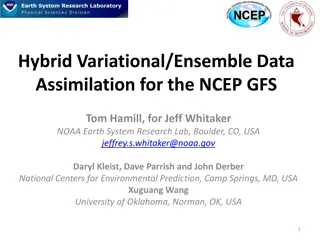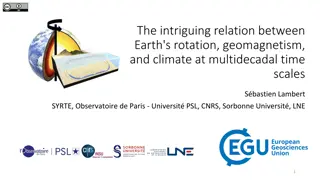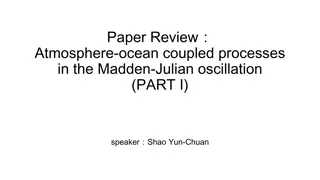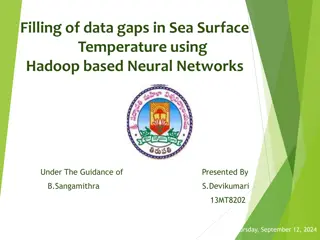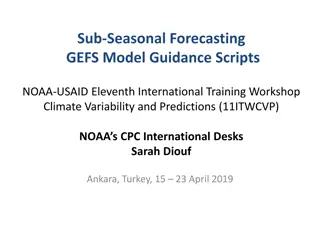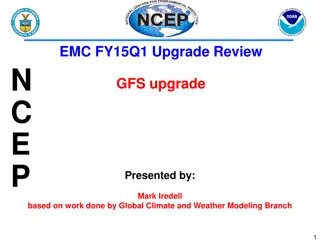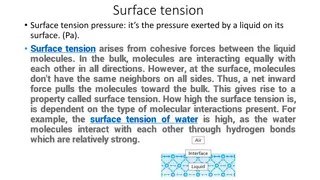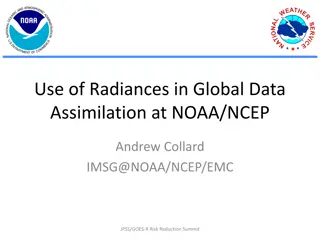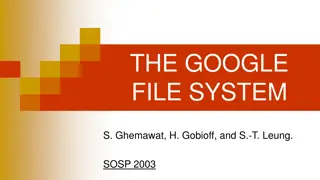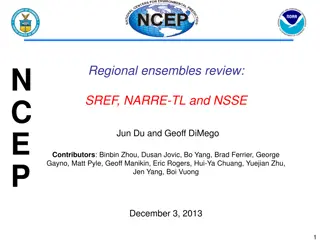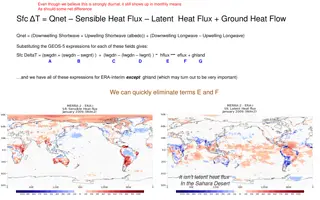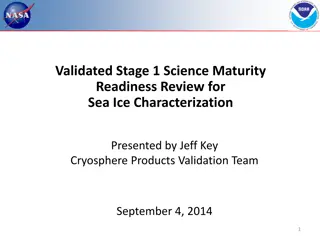Understanding Near-Surface Sea Temperature Development in NCEP GFS/CFS
This informative piece delves into the evolution of Near-Surface Sea Temperature (NSST) within the NCEP GFS/CFS, discussing its significance in Numerical Weather Prediction (NWP) systems, the utilization of sea surface temperature (SST), and the T-profile near the sea surface. It covers the role of NSST in atmospheric forecast models, mixed layer temperature dynamics, and diurnal thermal structures impacting NSST. A detailed exploration providing insights into the handling and implications of NSST in oceanic modeling and forecasting.
Download Presentation

Please find below an Image/Link to download the presentation.
The content on the website is provided AS IS for your information and personal use only. It may not be sold, licensed, or shared on other websites without obtaining consent from the author. Download presentation by click this link. If you encounter any issues during the download, it is possible that the publisher has removed the file from their server.
E N D
Presentation Transcript
The development of the NSST within the NCEP GFS/CFS Xu Li Acknowledgements: DA, MODEL and More
Outline Introduction The current ocean (SST) in NWP NSST (Near-Surface Sea temperature) NSST within the NCEP GFS NSST within the NCEP CFS (Future)
How SST is used in the current NWP system Currently in NWP, since the only oceanic variable used is SST SST = Oceanic Component SST analysis is used as an input to NWP system In fact, SST is evolving with time even if no prognostic model SST climatology with seasonal variability plus the decayed initial anomaly ( ) ( [ ) ( 0 0 t SST t SST t SST = d+ ( / ) 0 t t T lim lim fcst an c c )] ( ) e SST t 90 is the lower boundary condition of atmospheric forecast model Critical to the energy exchange at air-sea interface is the lower boundary condition of a radiative transfer model such CRTM Critical to the satellite radiance simulation the evaluation of the cost function, bias correction and quality control SSTfcst (t ) SSTfcst (t )
A Fact The existence of a mixed layer simplifies the handling of ocean SST = Bulk Temperature = Mixed Layer Temperature Acceptable coarse vertical resolution of OGCM All the observations can be used as SST Air-sea coupling not important since the sea is slow-evolving in NWP Others T mix T Mixed Layer Thermocline Deeper Ocean z 4
What is NSST (Near-Surface Sea Temperature)? NSST is a T-Profile just below the sea surface. Here, only the vertical thermal structure due to diurnal thermocline layer warming and thermal skin layercooling is resolved Diurnal Warming Profile f T f T = = ' ' ( ) 1 ( / ) ) 0 ( w T T z z z T w w mix c T ' T w z (z ) T w Mixed Layer = + Tw ~ ' ' ( , ) ( ) ( ( , ) ( , ) T z t T t T z t T z t w 'z ) 0 f c w z 5 ( ) zw O m Thermocline z Deeper Skin Layer Cooling Profile = = , 0 ( T ) c T ' ' ' , 0 ( c c T ) ) ( , z ) / ) 0 ( T 1 ( ) 0 ( c T t z t t Ocean c z c ' c T T T 'z ( ) Tc = = + ) ' ' ( , ) t ( , ) t ( ( , ) ) t ( , ) z ( t , T T z ( t , T T z z t T z t c ~ 1 ( ) O mm f w z w c z + ' z ) , z , 0 [ ] w z 5 f w 4
Scientific Basis for the improvement The more realistic ocean Inclusion of the NSST variability The more effective use of observations More observations All observations available in GSI of NCEP GFS plus AVHRR, AMSRE and in situ sea temperature (buoys, ships ) Direct assimilation Exact the information from the indirect observation more effectively Coupled (partially) data assimilation and prediction Analysis More consistent atmospheric and oceanic initial conditions by minimizing a single cost function Forecasting Prognostic SST by the coupling of atmosphere and ocean 6
Monthly mean SST diurnal variability (SD) for EXP. July, 2010 January, 2011
Features in different SST analysis Features Current GFS GHRSST NSST Well-defined Analysis variable No Yes Yes Multi-Satellite No Yes Yes Direct Assimilation No No Yes Obs. with diurnal warming used Yes No Yes Diurnal variability resolved No Yes Yes Tf variability N/A No Yes NSST model used consistently N/A No Yes Coupled analysis No No Yes (partially) 8
Current oceanic component (SST) in the NCEP GFS FCST ANAL IC an X Atmospheric Forecasting Model Atmospheric Analysis an ( ) X bg ( ) X bg X BG SSTfcst (t ) Radiative Transfer Model (CRTM) Simulated radiance Jacobi s an SST SST Analysis: = fcst ( , ) ( ) T z t SST t crtm ch = d+ ( / ) 0 t t T lim lim fcst an c c ( ) [ ( ) ( )] ( ) SST t SST t SST t e SST t 90 0 0 9
The NSST within the NCEP GFS FCST ANAL anT an f X , IC Atmospheric Forecasting Model (AFM) Atmospheric Analysis (GSI) f T Analysis (NSSTAN) bgT X , bg f , z NSST Model (NSSTM) BG ' ' ( , ), ( ) T z t T t w c = + ' ' fcst an f ( ) ( ) , 0 ( w ) , 0 ( c ) SST t T t T t T t 0 Radiative Transfer Model (CRTM) Simulated radiance Jacobi s = + ' ' ( , ) ( ) ( , ) ( , ) T z t T t T z t T z t 0 crtm ch f w ch c ch
SST or oceanic variable verification O B Bias & RMS to the own analysis RMS to the buoy observation
(a) Bias to own analysis (c) Bias to buoy observation (b) RMS to own analysis (d) RMS to buoy observation The verification of RTG SST (Black, used in the coming implementation), NSST SST (Red), Reynolds SST (Green, used in current operational) and Tf in NSST (Blue) for November 2013. The starting time is 00Z.
Histogram of (O F) for predicted SST. 10/22/3013 11/27/2013. Global, Control: [T_ob(z) SST fcst]
Histogram of (O F) for predicted SST. 10/22/3013 11/27/2013. Global, NSST/EXP: [T_ob(z) T_fcst(z)]
Histogram of (O F) for predicted SST. 10/22/3013 11/27/2013. Global, Operational: [T_ob(z) SST fcst]
Time series of SST/Tf analysis. Area: (141 W 139 W, 4S 4N) OPR SSTANAL EXP Tf ANAL CTL SST ANAL EXP SST ANAL
Time series of SST/Tf analysis and prediction. Area: (141 W 139 W, 4S 4N) EXP Tf ANAL CTL SST ANAL EXP SST ANAL EXP Tf FCST CTL SST FCST EXP SST FCST OPR SST ANAL OPR SST FCST
Time series of (O B), 2013102200 - 2013102818. Area: (141 W 139 W, 4S 4N) CTL EXP OBS (buoy)
Why SST, an oceanic variable, is analyzed in an atmospheric data assimilation system? More consistent initial conditions A single cost function and air-sea interaction More effective use of satellite data Assimilating satellite radiance directly to analyze the oceanic variable Taking advantage of the atmospheric data assimilation Advanced and updated frequently A direction to coupled data assimilation A single cost function for two media
Coupled Data Assimilation Coupled data assimilation (definition) Assimilation into a coupled model where observations in one medium are used to generate analysis increments in the other. This means a simultaneous minimization of a single cost function for atmosphere and ocean. Loosely coupled data assimilation (NCEP CFS, NAVY, ECMWF) The background for each medium is generated by a coupled integration but the analysis is done independently. NSST A single cost function A coupled model No Tf evolution No error covariance between ocean and atmosphere 20
Coupled Prediction The SST in coupled model may not be better than the persistent one as used in the operational NWP Since the unconstrained models tend to develop their own climatological bias in 5 days for atmosphere and a few months for ocean respectively The evolving SST due to the couple allows the system to progress more faithfully. The negative feedback mechanism due to the couple can retard the growth of some errors. Weather forecasting The bias hasn t developed yet Climate prediction 21
Problems in NSST and Coupled Prediction System A primary problem in NSST Steady in forecasting A primary problem in loosely coupled data assimilation such as NCEP CFS An independent SST analysis is used as the first layer temperature ( ) of OGCM Mismatch quick adjustment in the initial forecasting period Too weak SST diurnal variability A primary problem in all coupled prediction The first layer s temperature, , is used as SST f T T 1z T 1z 1= 10 z m 22
One solution The relationship among ' ' ( ), , T z T T andT f w c = + ' ' ( ) ( ) ( ) T z T T z T z f w c The following conversion can be derived by integrating the above equation from z=0 to z=z1 0 0 z 1 = + ' ' / 1 ( ) [ ( ) ( )] T T z T z T z dz z 1 f w c 1 z 1 = ' ' / 1 ( ) [ ( ) ( )] T T z T z T z dz z 1 f w c 1
A scheme to combine NSST and NCEP CFS Coupled initialization Consistent with the other oceanic variables T 1z z 1 an z 0 = + ' ' an f ( ) ( ) / 1 ( ) [ ( , ) ( , )] T t T t z T z t T z t dz 1 w c 1 Coupled prediction Evolving f T z 1 0 = ' ' ( ) ( ) / 1 ( ) [ ( , ) ( , )] T t T t z T z t T z t dz z 1 f w c 1 Real SST instead of used at the interface T 1z = + ' ' fcst ( ) ( ) , 0 ( w ) , 0 ( c ) SST t T t T t T t 24 f
z 1 z 1 0 = ' ' [ ( ) ( )] T T T z T z dz z f w c 1 1 25
Combination of NSST and NCEP CFS FCST ANAL Atmospheric Forecasting Model ( X Atmospheric Analysis ( X an z 1 an an f , , X T T IC an bg ) ) an ( ) fT fT Analysis Analysis + X fcst SST s ' ' bg w bg ( ), ( ) T z T z bgT X , T bg f bg ' c ' ' bg w bg NSSTM ( + , ) T T BG c ', bg w T c T = OGCM T an z 1 T z Analysis 1 1 = fcst fcst ( ) 0 , 0 ( ) SST t T t Radiative Transfer Model (CRTM) Rch= R [ , , ( / )] T C X X T z z 1 z 1 = ' ' ( ) ( ) [ ( , ) ( , )] T t T t T z t T z t dz / R z f w c 1 ch ch z 1 ch = fcst ( , ) ( , ) T z t T z t crtm ch ch = + ' ' fcst bg f bg w bg ( , ) ( , ) ( , ) ( , ) T z t T z t T z t T z t 62 w c
Incorporation of the NSST into an air-sea coupled data assimilation and prediction system ANALYSIS FORECAST Hybrid ENKF GSI with Tf analysis built in , [ X Atmospheric FCST Model with NSST Model built in , [ T X a an a an o an f ( , , ) X X T IC an a T an f ' bg bg ] ( )] z X : Atmospheric state vector a Get skin-depth dependent T(z) bg fT bg Get and then for fT bg SST Observation the coupling with NSST T-Profile )] ( [ z Tbg innovation in Tf analysis SST(z) = SSTfnd + Tw (z) - Tc (z) T(z) = Tf (zw ) + T (z) with and NSST T-Profile ) ( z Tbg ' and Oceanic model Tbg o ' [ ( )] z T-Profile Hybrid GODAS ( o X Oceanic FCST Model ( o X bg a bg o bg f , , X X T BG bg an ) ) X : Oceanic state vector o NSST algorithm is part of both the analysis and forecast system. In the analysis, the NSST provides an analysis of the the interfacial temperature ( SST ) in the hybrid ENKF GSI using satellite radiances. In the forecast, the NSST provides the interfacial temperature (SST) in the free, coupled forecast instead of the temperature at 5-meter depth that is predicted by the ocean model. Xu Li, EMC
Discussions NSST and Reanalysis SST analysis SST diurnal variability Ocean Weather prediction Climate predition
